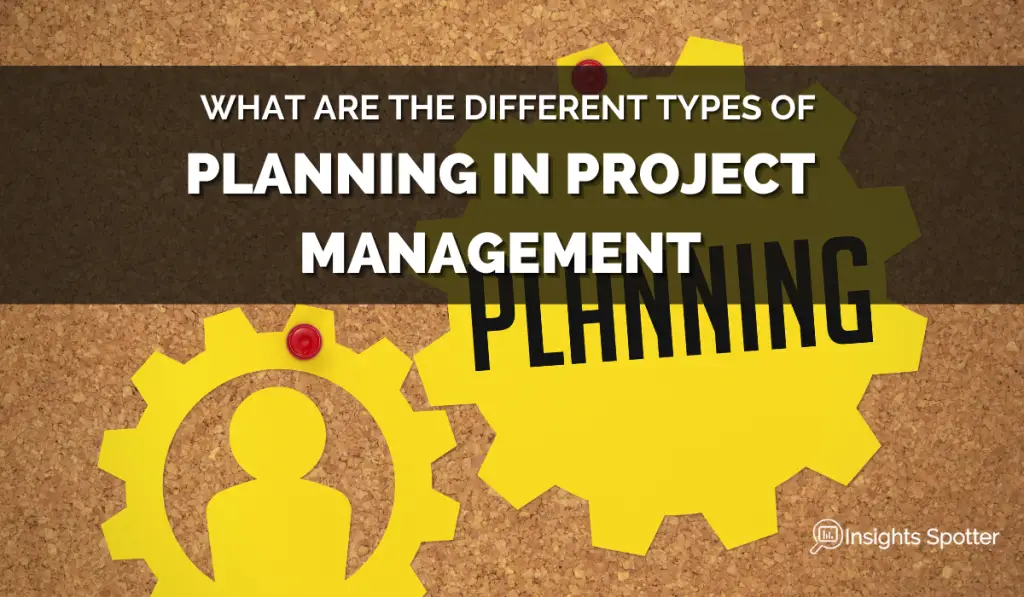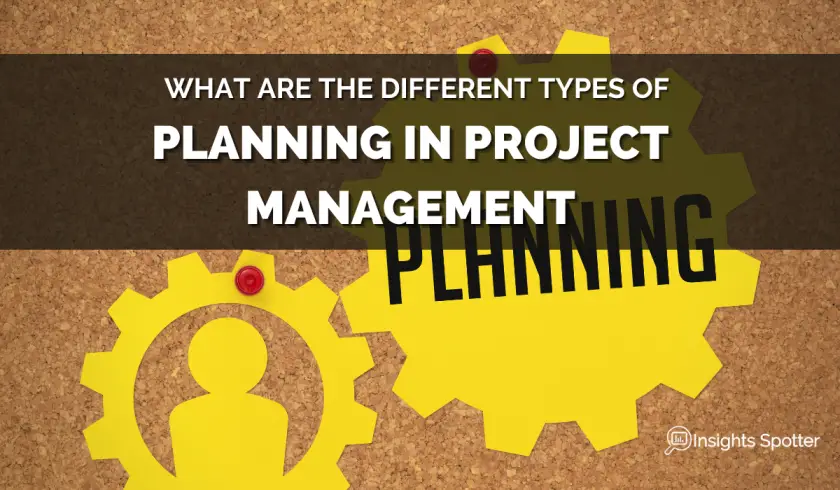What are the Different Types of Planning in Project Management?
Project planning covers defining the various stages based on the methodology used, allocating budget and resources, and assessing key performance metrics.
Without proper project planning, tracking and hitting objectives become more difficult, resulting in bottlenecks or roadblocks that hinder project success. On the flip side, if you have a comprehensive project plan, you can easily follow a more streamlined timeline and process.
Learn what goes into a project plan and the different types of planning you should consider as you read on.
Strategic Planning
Developing a strategic project management plan involves the identification of project goals and operational priorities, assessing resource availability, and the creation of a viable action plan depending on these variables. This type of plan sets the overall direction and objectives of the project as it contains critical aspects like the project objectives, timeline, and budget.
In strategic planning, use various project management tools – starting with SWOT analysis. Identifying SWOT, which stands for strengths, weaknesses, opportunities, and threats, helps you make well-informed decisions and design the project’s direction.
On top of that, use other processes, such as PESTLE analysis and stakeholder management. Evaluating PESTLE (political, economic, sociocultural, technological, legal, and environmental factors) provides a clearer picture of external aspects to consider when planning the project.
Meanwhile, stakeholder management strategies ensure you establish good relationships with the stakeholder. This plays an essential role in the project development and completion.
Scope Planning
Scope planning is another crucial aspect of project management planning which defines and documents the boundaries and project deliverables. By identifying the extent of the project in terms of the expected output and how it compares to other variables, you’ll have a clear picture of the necessary steps to attain the project goals.
To document the project deliverables, you first need to develop the scope statement, also known as the terms of reference. Your scope statement will be an essential part of your team’s roadmap when identifying the necessary steps to complete the deliverables within the agreed timeline and allotted budget. That said, it’s a key metric in measuring the project’s success.
Your scope management plan contains the scope statement. Keep in mind that despite the name, this is a comprehensive document not limited to a brief statement. Instead, you will have to cover important requirements to develop a clear project scope statement. In doing so, make sure to follow these steps:
- Discuss the creation of a scope statement with the stakeholders so they can also contribute to the brainstorming process
- Define the project requirements, such as your business and project goals, critical business processes involved, project assumptions and constraints, exclusions, success factors, and proposed deliverables statement.
Once you’ve completed the document, you’ll have to present the scope statement to the stakeholders. It’s not unlikely for it to change depending on how your discussion goes. To manage these changes, make sure to align the proposed alterations to the project’s budget and timeline.
Schedule Planning
Much like scope planning, you will need a viable schedule plan to take off with your project implementation. Schedule planning involves creating a timetable that includes milestone projections, task start dates, and due dates, and resources. These details are organised in such a way that ensures project completion within the declared timeline.
You can use several techniques to ensure you’re following the right process in schedule planning. For example, consider the Work Breakdown Structure (WBS) if you’re working on a complex project requiring multiple steps.
WBS is deliverable-oriented and follows a hierarchy of work to complete a parent task. Each level is a smaller component of a task, which contains its own details. The WBS methodology makes use of visual tools like flowcharts, Gantt charts, and other diagrams.
On the other hand, you can also use the Critical Path Method (CPM) when developing your schedule plan. This strategy focuses on finding the duration of tasks and identifying how critical they are in project completion. It also involves analysis of which project is dependent on the other. That way, it provides a gated process that allows you to better decide on creating a favourable schedule for your team.
While the scheduling techniques mentioned above work best for traditional projects, you may have to consider another option if you’re using the Agile methodology. This is because Agile is sprint-based, with iteration and more flexibility. An ideal schedule management approach for Agile begins with identifying the tasks based on priority, then grouping them under sprints. Also, categorise them based on status: not yet started, in progress, and completed.
Scheduling the critical components of the project becomes easier when using project management software. This is because they come with built-in scheduling tools, along with other essential features, for collaboration, notifications, and more.
Budget Planning
Regardless of how new you are in project management, you’re probably aware of how important budget planning is to move your project to the next steps. With so much at stake, budget planning has to be done with accuracy, proper analysis, and foresight,
Budget planning involves estimating, allocating, and controlling project costs. To create a project budget, you must first develop the project goals and scope statement and identify the deliverables. Next, you should create a list of resources you’ll need and assign estimated amounts. Make sure to cover all possible expenses to avoid going over budget. Then create a contingency fund. Make sure to document all these elements to create a budget plan.
In the event that you’re working on a no-budget project, don’t skip this planning step. At the very least, identify the necessary resources and indicate how you plan to obtain them.
Before you present your budget proposal to the stakeholders, include your plan for tracking and controlling project expenses throughout the project cycle, as well as any approach to reduce project costs. This improves the likelihood of your budget plan getting approval and prevents spending beyond the budget.
Resource Planning
Planning your resources go hand-in-hand with developing a budget plan. A resource plan helps with your cost allocation, allows you to minimise delays and other roadblocks, ensures alignment between the resources and deliverables, and optimises the use of available options.
To ensure proper resource planning, you must identify the necessary resources and check their availability in the business. For example, if your project involves promotional campaigns, assess if the business already has a marketing team so you don’t need to form one. This makes up resource optimization.
Other techniques you can employ include:
- Resource estimation: This involves identifying the type of resource and how many of each is required to complete the project.
- Resource leveling: This is a technique referring to adjusting the timetable to match it with the available resources, ensuring project completion.
- Resource smoothing: Unlike resource leveling, you opt not to change the project completion date. Instead, you optimise your resources by hiring new people, adding equipment, or other resource extensions that help you deliver the project on time.
Risk Planning
Managing risks allow for minimal roadblocks or a better way to manage them accordingly during project implementation. Risk planning is crucial to identify possible causes of bottlenecks and opportunities throughout the project.
The first step in planning a risk management strategy is risk identification. To do this, you’ll need to follow a streamlined process, which includes these steps:
- Template specification: This involves identifying risks based on various aspects like effects, causes, impacts, areas of risk, and events.
- Basic identification: It’s as simple as asking how likely or unlikely you’ll experience a particular risk (why or why not us) and where we have seen this before. The likelihood of a risk, in particular, can be covered by the SWOT analysis.
- Detailed identification: This technique can be time-consuming only because it includes thorough steps to analyse the risk, such as interviewing, assumptions analysis, document reviews, Delphi technique, and brainstorming.
Risk identification alone will be insufficient if you wish to reduce the impact of potential threats or maximise the visibility of opportunities. Supplementing this step is risk assessment, where you analyse the consequence of each risk and which aspects of the project phase or iteration can be highly affected.
By evaluating each risk, you can now create a response plan. It should contain strategies to mitigate the negative risks, as well as highlight and reach positive risks.
Communication Planning
Coming up with a communication plan allows you to establish the right channels to exchange updates, requests, and reminders. You also get to monitor the types of information your team members and stakeholders will have access to.
A communication plan outlines the method of communication, the tools you’ll be using, notification responses, and the frequency of update reports. It also contains the goal of the communication plan, the individual roles of the team members and stakeholders, and more.
In creating a communication plan, ensure that you outline which aspects of the project require communication and how often you should connect with specific people. It’s also ideal for identifying channels of communication and the level of engagement required from stakeholders as part of your efforts for stakeholder management.
Your communication plan will also likely influence the type of project management software you’d want. For example, if you plan on using tools like Slack to collaborate with your team members, it’s best to consider a PM platform that integrates with this app.
Quality Planning
Quality planning ensures that you meet the expected output within the time frame and allocation you’ve identified. On top of that, this type of planning also guarantees that the outcomes meet the set quality standard during the planning and initiation phase.
A key component of quality planning is setting your key performance indicators or quality metrics. These could be influenced by customer satisfaction, stakeholders’ expectations, and process quality standards.
To ensure proper quality planning, define the quality standards first. This will vary depending on the project goal. For example, if you’re aiming to develop a specific product, your quality standards will most likely include functionalities of specifications and particular attributes. These will also cover your quality objectives.
Once you’re set the quality standards and objectives, it’s time to plan for the quality assurance and control activities. These include testing and assessment in between iterations.
Procurement Planning
As an extension of resource planning, you should also ensure procurement planning when developing your project proposal document. Procurement planning involves identifying and acquiring the services, tools, equipment, and crucial needs to complete the project.
By having a procurement plan, you guarantee transparency and accountability in managing resource expenses. Plus, it allows you to monitor your acquisitions based on your budget and resource allocation.
In preparing your document, you should define and outline the procurement process. The crucial steps to consider include developing criteria for vendor selection, providing details on the bidding process, contract management, and supplier relationship management.
Conclusion
It’s no secret that planning plays an important role in building the foundation for the project’s success. Comprehensive planning leads to successful project execution. It encompasses the different types of project management planning, including strategic, scope, schedule, budget, resource, risk, communication, quality, and procurement planning. Therefore, make sure you include these types of planning in your project management practices.
Subscribe to our newsletter!
 ABOUT ME
ABOUT ME
I am an experienced ex. Business & Data Analyst and now a Project Manager with multiple years of experience gained in several international companies.
These days, business problems require data crunching and telling stories to make the right decisions. Simply put, business stakeholders need insights into their projects and deliveries.
This is where I come in. I have learned and applied Python, Power BI, SQL and Excel to analyse and present data. Also, I gained experience in Project Management and Business Analysis. So, I can not only spot insights but execute business decisions. Moreover, I can teach you as well. Read More
Best Books








Latest Blog Posts
- Sustainable Project Management: Trends, Tools, & Strategies
- Unlocking Strategic Value: How NIST CSF 2.0 Shapes Project Choices for Better Outcomes
- Cybersecurity Project Management: Protecting Your Digital Frontier
- What are the Different Types of Planning in Project Management?

- Transforming Project Management with AI Software: Tools, Challenges, and Best Practices
- Unlocking the Benefits of AI-Powered Project Management
Need Project Manager’s Help!?
Check out the Fiverr marketplace if you do not have time to run your own projects or just need extra help. They do have multiple project professionals, including project managers. Maybe you will find just the right fit to take some burden from you. I have used Fiverr in the past. The prices are also not too bad. If you seek PM via the corporate route, it will be easily 5x the price.

